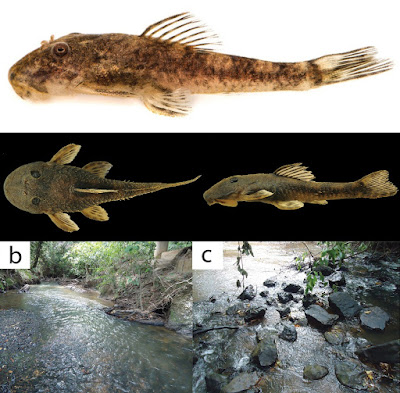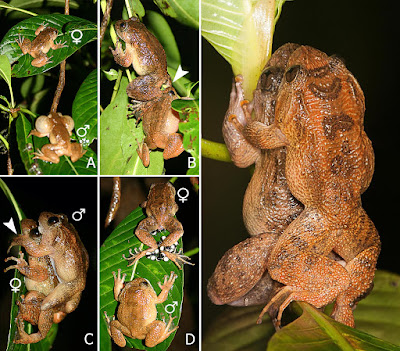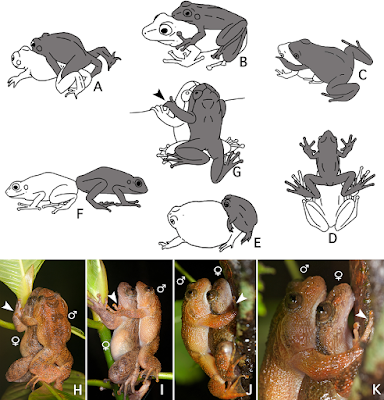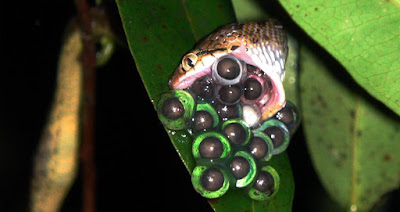[Most Recent Entries] [Calendar View]
Wednesday, June 15th, 2016
| Time | Event | ||||||
| 6:04a | [Ichthyology • 2016] Microplecostomus forestii • Description of A New Catfish Genus (Siluriformes, Loricariidae) from the Tocantins River Basin in central Brazil, with Comments on the Historical Zoogeography of the New Taxon
Abstract This study presents the description of a new genus of the catfish subfamily Neoplecostominae from the Tocantins River basin. It can be distinguished from other neoplecostomine genera by the presence of (1) three hypertrophied bicuspid odontodes on the lateral portion of the body (character apparently present in mature males); (2) a large area without odontodes around the snout; (3) a post-dorsal ridge on the caudal peduncle; (4) a straight tooth series in the dentary and premaxillary rows; (5) the absence of abdominal plates; (6) a conspicuous series of enlarged papillae just posterior to the dentary teeth; and (7) caudal peduncle ellipsoid in cross section. We used maximum likelihood and Bayesian methods to estimate a time-calibrated tree with the published data on 116 loricariid species using one nuclear and three mitochondrial genes, and we used parametric biogeographic analyses (DEC and DECj models) to estimate ancestral geographic ranges and to infer the colonization routes of the new genus and the other neoplecostomines in the Tocantins River and the hydrographic systems of southeastern Brazil. Our phylogenetic results indicate that the new genus and species is a sister taxon of all the other members of the Neoplecostominae, originating during the Eocene at 47.5 Mya (32.7–64.5 Mya 95% HPD). The present distribution of the new genus and other neoplecostomines may be the result of a historical connection between the drainage basins of the Paraguay and Paraná rivers and the Amazon basin, mainly through headwater captures. Keywords: Molecular phylogeny, Freshwater fishes, headwater capture, catfish, taxonomy Microplecostomus gen. n. Type species: Microplecostomus forestii sp. n. Diagnosis: The new genus and species differs from all members of the Loricariidae by having (1) three hypertrophied bicuspid odontodes on the lateral portion of the body (character apparently present only in mature males – observed in the holotype, but not present in the paratypes) (Fig. 2a, b); and differs from all members of the Neoplecostominae by having (2) a large area without odontodes around the snout, observed in all specimens, Fig. 3 (vs. margin of snout bearing odontodes); and from all members of the Neoplecostominae, except Hirtella carinata Pereira, Zanata, Cetra & Reis, 2014, Pareiorhina carrancas Bockmann & Ribeiro, 2003 and Pareiorhina hyptiorhachis Silva, Roxo & Oliveira, 2013 by (3) the presence of a post-dorsal ridge on the caudal peduncle, see dorsal view of holotype in Figs 1, 4 (vs. the absence of a post-dorsal ridge). Microplecostomus forestii sp. n. differs from species of the genera Isbrueckerichthys, Neoplecostomus and Pseudotocinclus by (4) the absence of abdominal plates, Fig. 1 (vs. abdomen covered by pentagonal or hexagonal platelets); from Kronichthys by having (5) the tooth series in dentary and premaxillary rows straight (vs. tooth series strongly curved medially); from Neoplecostomus by (6) the absence of a conspicuous series of enlarged papillae just posterior to the dentary teeth (vs. presence of enlarged papillae); and from Pseudotocinclus by having (7) the caudal peduncle ellipsoid in cross section (vs. caudal peduncle square in cross-section). Etymology: The generic name is a combination of Greek, micro (mikrós) = small, related to the small size of the adult type-specimen, and plecostomus = a former generic name of species currently included in Loricariidae, also in reference to the small adult size of the type-species. A masculine name.
Microplecostomus forestii sp. n. http://zoobank.org/2A1A0D93-ED90-4C5F-95 Holotype: MZUSP 118673 (adult male, 38.3 mm SL), Brazil, Goiás state, municipality of São João D’Aliança, Roncador Stream, a tributary of das Brancas Stream, tributary of the Tocantizinho River, Tocantins River basin, 14°53'47.2"S, 47°34'58.4"W, 9 November 2014, FF Roxo, GSC Silva, LEO Ochoa, LH Roxo. Etymology: The specific name, forestii, is given in honor of Fausto Foresti, Professor of the university of São Paulo state “Júlio de Mesquita Filho” (Unesp) in Brazil, for his contributions to fish genetics, with more than 250 papers published in this field. Distribution: Microplecostomus forestii sp. n. is known from two localities, the Roncador Stream and the das Brancas Stream, both tributaries of the Tocantizinho River, in the Tocantins basin (Fig. 7a). Habitat: Microplecostomus forestii sp. n. was collected in shallow, clear waters of about 0.5 m in depth and fast-flowing currents, with an underlying substrate of rock, in areas of flat terrain. The fishes captured were associated with pebbles (Fig. 7b, c). This species is relatively hard to collect and is not abundant. In seven expeditions to the Roncador and das Brancas streams in different periods of the year, we were able to collect only 16 specimens. Microplecostomus forestii sp. n. is sympatric with species such as Creagrutus sp., Rhinolekos capetinga Roxo, Ochoa, Silva & Oliveira, 2015, Hypostomus sp., Phenacorhamdia sp., Ancistrus sp., and Ituglanis sp. Gabriel S.C. Silva, Fábio F. Roxo, Luz E. Orrego and Claudio Oliveira. 2016. Description of A New Catfish Genus (Siluriformes, Loricariidae) from the Tocantins River Basin in central Brazil, with Comments on the Historical Zoogeography of the New Taxon. ZooKeys. 598: 129-157. DOI: 10.3897/zookeys.598.7400 | ||||||
| 9:19a | [Herpetology • 2016] A Unique Mating Strategy without Physical Contact During Fertilization in Bombay Night Frogs Nyctibatrachus humayuni with the Description of A New Form of Amplexus and Female Call Abstract Anurans show the highest diversity in reproductive modes of all vertebrate taxa, with a variety of associated breeding behaviours. One striking feature of anuran reproduction is amplexus. During this process, in which the male clasps the female, both individuals’ cloacae are juxtaposed to ensure successful external fertilization. Several types of amplexus have evolved with the diversification of anurans, and secondary loss of amplexus has been reported in a few distantly related taxa. Within Nyctibatrachus, a genus endemic to the Western Ghats of India, normal axillary amplexus, a complete loss of amplexus, and intermediate forms of amplexus have all been suggested to occur, but many species remain unstudied. Here, we describe the reproductive behaviour of N. humayuni, including a new type of amplexus. The dorsal straddle, here defined as a loose form of contact in which the male sits on the dorsum of the female prior to oviposition but without clasping her, is previously unreported for anurans. When compared to known amplexus types, it most closely resembles the form of amplexus observed in Mantellinae. Furthermore, we prove that, opposed to the situation in most anurans, male semen release happens before egg deposition. We hypothesize that the male ejaculates on the female’s dorsum and that sperm subsequently runs from her back and hind legs before fertilizing the eggs. A second feature characterizing anuran breeding is the advertisement call, mostly produced solely by males. Despite recent descriptions of several new Nyctibatrachus species, few studies have explored their vocal repertoire. We describe both the male advertisement call and a female call for N. humayuni. The presence of a female call has not been reported within Nyctibatrachidae, and has been reported in less than 0.5% of anuran species. Altogether, our results highlight a striking diversity and several unique aspects of Nyctibatrachus breeding behaviour.
  The Bombay Night frogs Nyctibatrachus humayuni in Dorsal straddle: A new amplexus mode in frogs. photo: SD Biju Conclusion The breeding behaviour of Nyctibatrachus humayuni has several unique elements: a new type of amplexus, the release of semen before oviposition and the presence of a female call. These findings further highlight the tremendous variation present in the reproductive behaviour of anuran amphibians. Nyctibatrachus frogs are one of several unique taxa in the Western Ghats biodiversity hotspot, which is heavily threatened by anthropogenic activities (Myers et al., 2000; Bossuyt et al., 2004; Van Bocxlaer et al., 2012). A good understanding of each species’ ecology, including reproduction, is of major importance for planning and successfully implementing conservation strategies. Additional studies further exploring the unique and diverse behaviour in Nyctibatrachus frogs are, therefore, badly needed. Special attention should be paid to describing the amplexus type, determining the moment of fertilization and assessing the presence and function of female calling behaviour. Bert Willaert, Robin Suyesh, Sonali Garg, Varad B. Giri, Mark A. Bee and S.D. Biju. 2016. A Unique Mating Strategy without Physical Contact During Fertilization in Bombay Night Frogs (Nyctibatrachus humayuni) with the Description of A New Form of Amplexus and Female Call. PeerJ. 4:e2117. DOI: 10.7717/peerj.2117 Discovery of a new mating position (the 7th to be discovered) in frogs. http://bit.ly/25KopKM via @ThePeerJ @EurekAlertAAAS Narahari Gramapurohit, Sachin Gosavi and Samadhan Phuge. 2011. Unique courtship and spawning behaviour in wrinkled frog, Nyctibatrachus humayuni. Amphibia-Reptilia. ResearchGate.net/publication/215634691_U Krushnamegh Kunte. 2004. Natural History and Reproductive Behavior of Nyctibatrachus cf. humayuni (Anura: Ranidae). Herpetological Review. 35(2), 137–140. http://www.biodiversitylab.org/sites/def |
| << Previous Day |
2016/06/15 [Calendar] |
Next Day >> |











